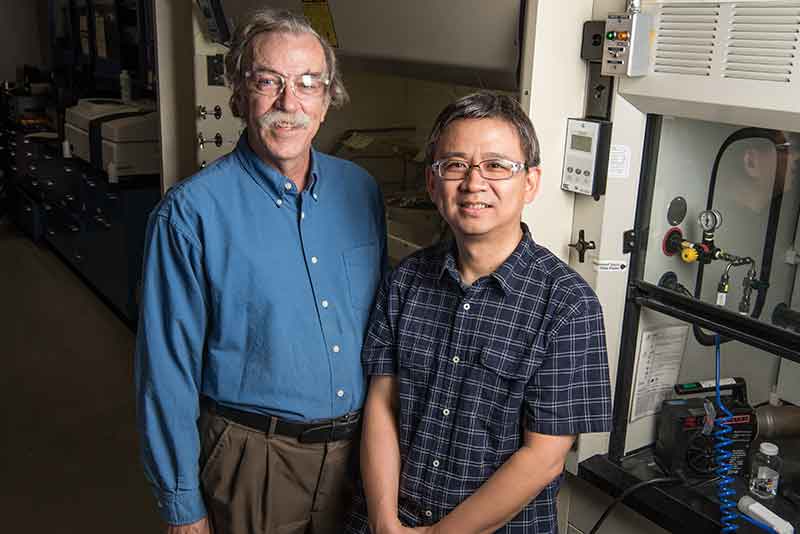By Wayne.Hicks@nrel.gov (Wayne Hicks)
Study highlights possible approaches to overcoming key challenges preventing perovskite solar cells from being competitive in the solar market
October 17, 2016
NREL Scientists Keith Emery and Kai Zhu collaborated with renowned scientists from Korea, Switzerland, and Japan to propose a strategy for producing stable and commercially available perovskite solar cells (PSCs). Photo by Dennis Schroeder/NREL.
A strategy for producing stable and commercially available perovskite solar cells (PSCs) has been proposed by Kai Zhu and Keith Emery at the Energy Department’s National Renewable Energy Laboratory (NREL), in collaboration with Nam-Gyu Park (Korea), Michael Grätzel (Switzerland), and Tsutomu Miyasaka (Japan).
Solar cells using a halide perovskite with an organic cation such as methylammonium and/or formamidinium have attracted considerable attention because of their excellent photovoltaic performance. Over a period of just a few years, their power conversion efficiency has rocketed to greater than 22 percent.
However, PSCs face challenges to commercialization. Specifically, they have the following needs that must be addressed for the eventual success of this promising technology: 1) long-term stability, 2) a manufacturing method that can produce reproducible, hysteresis-free, high-performance devices, and 3) reliable device characterization.
Nam-Gyu Park of Sungkyunkwan University initiated this joint effort to provide solutions to these needs, and the authors proposed a strategy-to move toward stable commercial PSCs-that includes the following:
- Developing a reproducible manufacturing method that takes into account managing grain boundaries and interfacial charge transport
- Using electroluminescence as an effective metric or tool for evaluating PSC quality
- Realizing the importance of the design of device structures with interface engineering to yield performance that is stable and hysteresis-free
- Recovering and utilizing the lead in PSCs to address environmental concerns
- Ensuring the advance of practical applications through reliable device characterization.
Details of the strategy are found in the paper, “Towards Stable and Commercially Available Perovskite Solar Cells,” published in Nature Energy. The authors are Nam-Gyu Park (Sungkyunkwan University, Korea), Michael Grätzel (Ecole Polytechnique Federale de Lausanne, Switzerland), Tsutomu Miyasaka (Toin University of Yokohama, Japan), and Kai Zhu and Keith Emery from NREL.
The work at NREL is supported by the U.S. Department of Energy SunShot Initiative. SunShot is a collaborative national effort that aggressively drives innovation to make solar energy fully cost-competitive with traditional energy sources before the end of the decade. Through SunShot, the Energy Department supports efforts by private companies, universities, and national laboratories to drive down the cost of solar electricity to 6 cents per kilowatt-hour. Learn more at energy.gov/sunshot.
NREL is the U.S. Department of Energy’s primary national laboratory for renewable energy and energy efficiency research and development. NREL is operated for the Energy Department by The Alliance for Sustainable Energy, LLC.
Visit NREL online at www.nrel.gov
Read more here:: http://feedproxy.google.com/~r/NrelNewsReleases/~3/4YcN154m9AQ/37752














